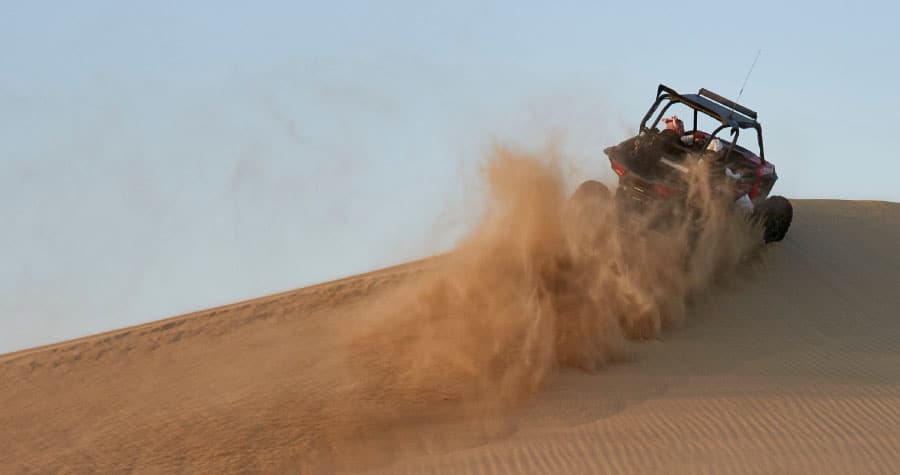
When we think of dune buggies, we usually think of dune bashing and cruising along the beach. Both of these activities, along with most other activities we enjoy with our dune buggies, don’t necessarily involve high speeds, but have you ever wondered how fast dune buggies can actually go? Well, so have I.
The average top speed of most standard dune buggies is around 60mph, while modified dune buggies can reach top speeds in access of 100mph. The Fornasari Racing Buggy can do 0 to 60 MPH in under 3.8 and has a top speed of 173mph.
That being said, it’s much more complicated to determine the top speed of dune buggies, cause the speed of a dune buggy is usually limited to what you do it. Whether you going over dunes all day or are you cruising down a winding road next to the ocean, either way, this is what will determine how fast you would go.
The original dune buggies got popular because by removing the roof and a lot of other extra junk, the buggy weighed substantially less.
What this meant was that an engine meant to push a large steel frame suddenly only had to propel a few wheels and the occupant driving it. Creating blistering acceleration and top speeds that were ludicrously unsafe, the best way to experience being young and irresponsible.
Then things changed when enthusiasts got involved, adding turbos, better suspension, and plenty of other additions, each making the buggies more fun, and much, much faster.
Top Speed in a Classic
Determining the top speed of most classic beach buggies is complicated. Kit dune buggies are similar, but within a few years of someone owning it, they aren’t anymore, due to the many modifications people tend to do on them.
There are reports of dune buggies going almost 100 mph, while others could never reach that fast, but they would easily go 0 to 60 under 15 seconds. Now, this doesn’t sound as impressive as modern sports cars, but doing that in an open-roofed vehicle with only fiberglass sides is a lot more dangerous.
The 1400cc and 1600cc VW engines, combined with the VW beetle’s 4-speed gearbox, made for lightweight powerhouses. This helped the dune buggies to comfortably reach 45mph speeds even when they were driving on roads sandier and muddier than ever thought of.
Later versions of the VW conversions had 5-speed gearboxes that allowed them to reach speeds of up to almost 70mph, however, this usually required straight roads and braver drivers.
When mechanics got hold of dune buggies, they started making modifications by adding larger tires for more grip, lighter bodywork wherever possible, and eventually adding turbos to the engines. This created buggies that were more fun, faster than before, and also perfect for long-distance racing, for those who were into that sort of thing.
For a bit of history, the original dune buggies that we now consider as classics were created in 1969 by Bruce Meyers. While they are now able to reach blistering speeds, they weren’t built for purely that. They were created to get over, around, and through giant sandy dunes comfortably and without ever getting stuck.
That’s where things changed, and when dune buggies got popular and started moving away from their easy-to-fix, easy to maintain VW engines.

Modern Speed Stars
While the classic VW engines were great, they lacked a few things when considering the way the world was changing. While Lotus was destroying the rally world and F1 cars were destroying all speed records, small-town mechanics were getting to work on their dune buggies and the speed of these buggies soon became rediculous and immeasurable.
Sometimes you would see buggies with small lightweight fiberglass panels, fitted with small chassis and wheels, attached to V8 engines. Other times water-cooled boxer engines would be attached for max performance-to-weight ratios. This meant that the buggies would easily reach absurd speeds, which also later caused the shape of the dune buggies to change.
Entering the modern era of dune buggies, they started improving in more ways like getting larger body works, different tires, and eventually more complex systems. Militaries started using them, anti-poachers in Africa started modifying them, and speed crazed adrenaline junkies started racing with them. Baja and Dakar are races where these vehicles are still favored for their ability to reach high speeds and ease to fix.
Modern dune buggies aren’t necessarily built from old VW beetles anymore, they can be completely custom-built using water-cooled engines and pieced together roll cages.
This makes it almost impossible to determine just how fast they can go and they rarely even have speedometers, to begin with. The only measure of speed you get is how fast the wind is whipping through your hair, or perhaps just your clothing.
These are just examples of cars used by sports drivers and mechanical enthusiasts, the love for these cars has caused them to easily reach top speeds close to 100mph. Maybe even more, but then it might be difficult to accurately measure how fast something is going when it’s flying over and under sand dunes, some even larger than mountains.
Getting a dune buggy doesn’t mean that you’ll be stuck with the slowest thing on the beach. With the right modifications, the right engine, and a lightweight body, you could easily reach any speed you want. However, if you aren’t ready to spend time and money fixing there is another solution, one that was introduced by the company that created the framework for the VW.
The I.D. Buggy introduced by Volkswagen as a concept in 2019 promised to be a new addition to the dune buggy line, with one weird twist. It sees the buggy fitted with the latest technologies; the I.D. Buggy is an all-electric dune buggy that can reach 65mph in only 7.2 seconds. It’s yet to enter production, but it will promise to breathe some new life into the world of buggies, even though it only has a range of 155 miles.
The Hard Facts
When it comes to dune buggies (commercially available ones) there are a few that should be mentioned along with their speeds.
- Meyers’s maximum legal speed limit is 45mph on public roads.
- Custom Sand Rails easily reach a top speed of up to 70mph.
- The Fornasari Racing Buggy reaches 0 to 60 MPH in under 3.8 and has a top speed of 173mph
- The BMS V-Twin Buggy 800 can reach a top speed of 60mph
Those are just a few of the popular dune buggies available on the market. Their speeds can still be varied depending on where you want to drive them and what your state laws say. The real top speed of a dune buggy is simply the top speed you are willing to go.
Conclusion
Now that we’ve been discussing the top speeds of dune buggies, classic and modern buggies alike, I think it’s time to get out there and have some fun and as I said, the real top speed of a dune buggy is simply the top speed you are willing to go.
Happy bashing!


